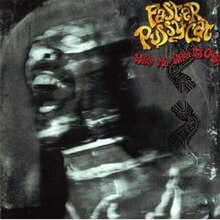Wake Me When It's Over is the second album by Faster Pussycat, released in 1989.[8] The band moved away from the glam metal of their first album to a more blues-influenced sound.[9]
| Wake Me When It's Over | ||||
|---|---|---|---|---|
 | ||||
| Studio album by | ||||
| Released | August 28, 1989[1] | |||
| Recorded | 1988–1989 | |||
| Genre | ||||
| Length | 60:42 | |||
| Label | Elektra[2] | |||
| Producer | John Jansen | |||
| Faster Pussycat chronology | ||||
| ||||
| Singles from Wake Me When It's Over | ||||
| ||||
| Review scores | |
|---|---|
| Source | Rating |
| AllMusic | |
| Chicago Tribune | |
| The Encyclopedia of Popular Music | |
| Los Angeles Times | |
| The Rolling Stone Album Guide | |
| St. Petersburg Times | |
Music videos were produced for "Poison Ivy" and "House of Pain". "House of Pain" reached No. 28 on the Billboard Hot 100, and the video, which was directed by future film director Michael Bay, was in rotation on MTV.[citation needed] The album peaked at No. 48 on the Billboard 200.[10] The album has been certified gold by the RIAA.[1]
Production
editThe album was produced by John Jansen. It is marked by a heavier, less glam metal sound.[5]
Critical reception
editSpin wrote that "side one is terrible, crammed with constipated glam-metal boogie, "but praised side two's "Slip of the Tongue" and "Tattoo".[11] The St. Petersburg Times wrote that "by smoothing out the rough edges and tightening up the loose performances, Faster Pussycat has traded in its identity for a faceless, albeit commercial, sound."[7] The Calgary Herald thought that "a pleasant surprise is "House of Pain", which is devoid of the syrupy mush that tends to dominate a lot of ballads that crack the charts."[12] Kirk Blows of Music Week called Wake Me When It's Over worthwhile, and noticed that the album gives listeners "more adventure, variety and depth than its predecessor while retaining just enough of the reckless spirit."[13]
Track listing
edit| No. | Title | Writer(s) | Length |
|---|---|---|---|
| 1. | "Where There's a Whip, There's a Way" | Taime Downe, Brent Muscat, Greg Steele | 6:44 |
| 2. | "Little Dove" | Downe, Muscat | 5:05 |
| 3. | "Poison Ivy" | Downe, Eric Stacy | 4:24 |
| 4. | "House of Pain" | Downe, Steele | 5:47 |
| 5. | "Gonna Walk" | Downe, Muscat, Steele | 4:24 |
| 6. | "Pulling Weeds" | Downe, Muscat | 4:35 |
| 7. | "Slip of the Tongue" | Downe | 4:32 |
| 8. | "Cryin' Shame" | Downe, Steele | 4:51 |
| 9. | "Tattoo" | Downe, Muscat, Steele | 4:56 |
| 10. | "Ain't No Way Around It" | Downe, Muscat, Steele | 4:31 |
| 11. | "Arizona Indian Doll" | Downe, Steele | 4:40 |
| 12. | "Please Dear" (not on all vinyl) | Downe, Muscat | 6:25 |
| Total length: | 60:42 | ||
Personnel
editFaster Pussycat
edit- Taime Downe – lead vocal
- Greg Steele – guitar, piano, backing vocal
- Brent Muscat – guitar, percussion, backing vocal, talk box on "Little Dove"
- Eric Stacy – electric and fretless bass
- Mark Michals – drums, percussion
Additional musicians
edit- Emi Canyn – vocals
- Jimmy Zavala – harmonica, saxophone
- Kevin Savigar – piano and keyboards
- Steven Riley – drums, percussion, backing vocals[citation needed]
Production
edit- Produced and mixed by John Jansen
- Recorded and engineered by Ryan Dorn, Ross Hogarth, John Jansen and Rod O'Brien
- Assistant engineers: Nelson Ayres, Kyle Bess, Michael Bosley and David Knight
- Mastered by Greg Calbi
Charts
edit| Chart (1989-1990) | Peak position |
|---|---|
| UK Albums (OCC)[14] | 35 |
| US Billboard 200[15] | 48 |
Certifications
edit| Region | Certification | Certified units/sales |
|---|---|---|
| United States (RIAA)[16] | Gold | 500,000^ |
|
^ Shipments figures based on certification alone. | ||
See also
editReferences
edit- ^ a b "Gold & Platinum". RIAA. Retrieved 2021-05-31.
- ^ a b The Rolling Stone Album Guide. Random House. 1992. p. 241.
- ^ Huey, Steve. Wake Me When It's Over at AllMusic
- ^ Kot, Greg (9 Nov 1989). "Home Entertainment....Recordings". Chicago Tribune. p. 15E.
- ^ a b Larkin, Colin (2006). The Encyclopedia of Popular Music. Vol. 3. MUZE. p. 402.
- ^ Gold, Jonathan (29 Oct 1989). "POP MUSIC SPECIAL The Record Industry's Big Push". Los Angeles Times. p. 52.
- ^ a b Hall, Ken (20 Oct 1989). "SOUND BITES". St. Petersburg Times. p. 17.
- ^ Phillips, William; Cogan, Brian (March 20, 2009). Encyclopedia of Heavy Metal Music. ABC-CLIO. ISBN 9780313348013 – via Google Books.
- ^ Popoff, Martin (2014). The big book of hair metal : the illustrated oral history of heavy metal's debauched decade. Minneapolis, MN: Voyageur Press. p. 177. ISBN 978-0-7603-4546-7. OCLC 858901054.
- ^ "Faster Pussycat". Billboard.
- ^ "Spins". SPIN. SPIN Media LLC. November 1989.
- ^ Miller, Glen (9 Nov 1989). "Metal Discs". Calgary Herald. p. C5.
- ^ Blows, Kirk (7 October 1989). "Review: Faster Pussycat — Wake Me When It's Over" (PDF). Music Week. London: Spotlight Publications Ltd. p. 32. ISSN 0265-1548. Archived from the original (PDF) on 2 November 2021. Retrieved 24 January 2022 – via World Radio History.
- ^ "Official Albums Chart Top 100". Official Charts Company. Retrieved January 30, 2024.
- ^ "Faster Pussycat Chart History (Billboard 200)". Billboard. Retrieved January 30, 2024.
- ^ "American album certifications – Faster Pussycat – Wake Me When It's Over". Recording Industry Association of America.